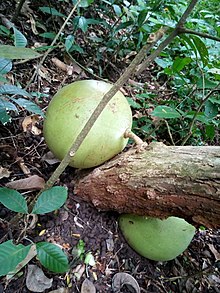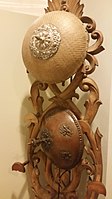Calabash
Calabash (Lagenaria siceraria), also known as bottle gourd,[1] white-flowered gourd,[2] long melon, New Guinea bean and Tasmania bean[3] is a vine grown for its fruit. It can be either harvested young to be consumed as a vegetable, or harvested mature to be dried and used as a utensil. When it is fresh, the fruit has a light green smooth skin and white flesh.
| Calabash | |
|---|---|
 | |
| Green calabash growing on its vine | |
| Scientific classification | |
| Kingdom: | Plantae |
| Clade: | Tracheophytes |
| Clade: | Angiosperms |
| Clade: | Eudicots |
| Clade: | Rosids |
| Order: | Cucurbitales |
| Family: | Cucurbitaceae |
| Genus: | Lagenaria |
| Species: | L. siceraria |
| Binomial name | |
| Lagenaria siceraria | |
| Synonyms | |
| |
Calabash fruits have a variety of shapes: they can be huge and rounded, small and bottle shaped, or slim and serpentine, and they can grow to be over a metre long. Rounder varieties are typically called calabash gourds. The gourd was one of the world's first cultivated plants grown not primarily for food, but for use as containers. The bottle gourd may have been carried from Africa to Asia, Europe, and the Americas in the course of human migration,[4] or by seeds floating across the oceans inside the gourd. It has been proven to have existed in the New World prior to the arrival of Christopher Columbus.[5]
Because bottle gourds are also called "calabashes", they are sometimes confused with the hard, hollow fruits of the unrelated calabash tree (Crescentia cujete), whose fruits are also used to make utensils, containers, and musical instruments.[6]
History
.jpg)
The bottle gourd is a commonly cultivated plant in tropical and subtropical areas of the world, which is believed to have originated from wild populations in southern Africa. Stands of L. siceraria, which may be source plants and not merely domesticated stands, were reported in Zimbabwe in 2004.[7] This apparent wild plant produces thinner-walled fruit that, when dried, would not endure the rigors of use on long journeys as a water container. Today's gourd may owe its tough, waterproof wall to selection pressures over its long history of domestication.[8]

Gourds were cultivated in Africa, Asia, Europe, and the Americas for thousands of years before Columbus' arrival to the Americas. In Europe,[9] Walahfrid Strabo (808–849), abbot and poet from Reichenau and advisor to the Carolingian kings, discussed the gourd in his Hortulus as one of the 23 plants of an ideal garden.[10][11]
The mystery of the bottle gourd – namely that this African or Eurasian species was being grown in the Americas over 8,000 years ago[12] – comes from the difficulty in understanding how it arrived in the Americas. The bottle gourd is usually thought to have drifted across the Atlantic Ocean from Africa to South America, but in 2005 a group of researchers suggested that it may have been domesticated earlier than food crops and livestock and, like dogs, was brought into the New World at the end of the ice age by the native hunter-gatherer Paleo-Indians, which they based on a study of the genetics of archaeological samples. This study purportedly showed that gourds in American archaeological finds were more closely related to Asian variants than to African ones.[4]
In 2014 this theory was repudiated based on a more thorough genetic study. Researchers more completely examined the plastid genomes of a broad sample of bottle gourds, and concluded that North and South American specimens were most closely related to wild African variants and could have drifted over the ocean several or many times, as long as 10,000 years ago.[13]
Cultivation
Bottle gourds are grown by direct sowing of seeds or transplanting 15- to 20-day-old seedlings. The plant prefers well-drained, moist, rich soil. It requires plenty of moisture in the growing season and a warm, sunny position, sheltered from the wind. It can be cultivated in small places such as in a pot, and allowed to spread on a trellis or roof. In rural areas, many houses with thatched roofs are covered with the gourd vines. Bottle gourds grow very rapidly and their stems can reach a length of 9 m in the summer, so they need a solid support along the stem if they are to climb a pole or trellis. If planted under a tall tree, the vine may grow up to the top of the tree. To obtain more fruit, farmers sometimes cut off the tip of the vine when it has grown to 6–8 feet in length. This forces the plant to produce side branches that will bear flowers and yield more fruit.
The plant produces white flowers. The male flowers have long peduncles and the females have short ones with an ovary in the shape of the fruit. Sometimes the female flowers drop off without growing into a gourd due to the failure of pollination if there are not enough bees in the garden. Hand pollination can be used to solve the problem. Pollen size is ~60 microns.

Crops are ready for harvest within two months; yield ranges from 35–40 tons/ha.
_in_Seoul.jpg) Pear-shaped bottle gourd in Seoul, Korea
Pear-shaped bottle gourd in Seoul, Korea- Slim, elongated upo squash, in San Rafael, Bulacan, Philippines
 Crook-necked "geese" cultivar in Granville Island Public Market, Canada
Crook-necked "geese" cultivar in Granville Island Public Market, Canada Serpentine snake gourds in Media, PA, United States
Serpentine snake gourds in Media, PA, United States Calabash flower
Calabash flower Calabash seeds
Calabash seeds_Bamako%2CML_mon29oct2007-1315h.jpg) Collection of bowls and spoons made of bottle gourd from Mali, 2007
Collection of bowls and spoons made of bottle gourd from Mali, 2007_DSCF3570.jpg)
Toxicity
Like other members of the family Cucurbitaceae, gourds contain cucurbitacins that are known to be cytotoxic at a high concentration. The tetracyclic triterpenoid cucurbitacins present in fruits and vegetables of the cucumber family are responsible for the bitter taste, and could cause stomach ulcers. In extreme cases, people have died from drinking the juice of gourds.[14][15][16] The toxic cases are usually due to the gourd being used to make juice, which the drinkers described as being unusually bitter.[17] In three of the lethal cases, the victims were diabetics in their 50s and 60s.[17] In 2018 a healthy woman in her early 40s was hospitalized for severe reactions after consuming the juice and died three days later from complications.[18]
The plant is not normally toxic when eaten. The excessively bitter (and toxic) gourds are due to improper storage (temperature swings or high temperature) and over-ripening.[19]
Culinary uses
Central America
In Central America the seeds of the bottle gourd are toasted and ground with other ingredients (including rice, cinnamon, and allspice) to make one type of the drink horchata.
East Asia
China
The calabash is frequently used in southern Chinese cuisine in either a stir-fry dish or a soup.
Japan

In Japan, it is commonly sold in the form of dried, marinated strips known as kanpyō and is used as an ingredient for making makizushi (rolled sushi).
Korea
Traditionally in Korea, the inner flesh has been eaten as namul vegetable and the outside cut in half to make bowls. Both fresh and dried flesh of bak is used in Korean cuisine. Fresh calabash flesh, scraped out, seeded, salted and squeezed to draw out moisture, is called baksok. Scraped and sun-dried calabash flesh, called bak-goji, is usually soaked before being stir-fried. Soaked bak-goji is often simmered in sauce or stir-fried before being added to japchae and gimbap.[20][21] Sometimes uncooked raw baksok is seasoned to make saengchae.
.jpg) Bak-namul (seasoned calabash side dish)
Bak-namul (seasoned calabash side dish)
Southeast Asia
Burma
In Burma, it is a popular fruit. The young leaves are also boiled and eaten with a spicy, fermented fish sauce. It can also be cut up, coated in batter and deep fried to make fritters, which are eaten with Burmese mohinga.
Philippines
In the Philippines, calabash is often cooked with pork and sotanghon noodles and served on top of rice.
- Upo (bottle gourd or calabash) with sotanghon
Vietnam
In Vietnam, it is a very popular vegetable, commonly cooked in soup with shrimp, meatballs, clams, various fish like freshwater catfish or snakehead fish or crab. It is also commonly stir-fried with meat or seafood, or incorporated as an ingredient of a hotpot. It is also used as a medicine. Americans have called calabashes from Vietnam "opo squash".
The shoots, tendrils, and leaves of the plant may also be eaten as greens.
South Asia
India
A popular north Indian dish is lauki channa, (channa dal and diced gourd in a semi-dry gravy). In the state of Maharashtra in India, a similar preparation called dudhi channa is popular. The skin of the vegetable is used in making a dry spicy chutney preparation. It is consumed in Assam with fish curries, as boiled vegetable curry and also fried with potato and tomatoes. Lauki kheer (grated bottle gourd, sugar and milk preparation) is a dessert from Telangana, usually prepared for festive occasions. In Andhra Pradesh it is called Anapakaya and is used to make Anapakaya pulusu (with tamarind juice), Anapakaya Palakura(curry with milk and spices) and Anapakaya Pappu (with lentils) Lau chingri, a dish prepared with bottle gourd and prawn, is popular in West Bengal. It's also called kaddu in Hindi and it is consumed as a dish with rice or roti for its medicinal benefits.
Bangladesh
In Bangladesh the fruit is served with rice as a common dish.
Nepal
In Nepal, in the Madheshi southern plains, preparations other than as a normal vegetable include halwa and khichdi.
Pakistan
In Pakistan, the calabash is cultivated on a large scale as its fruit are a popular vegetable.
Sri Lanka
In Sri Lanka, it is used in combination with rice to make a variety of milk rice, which is a popular dish in Sri Lanka.
Cultural uses
Africa
Hollowed-out and dried calabashes are a very typical utensil in households across West Africa. They are used to clean rice, carry water, and as food containers. Smaller sizes are used as bowls to drink palm wine. Calabashes are used in making the West African instruments like the Ṣẹ̀kẹ̀rẹ̀, a Yoruba instrument similar to a maracca, kora (a harp-lute), xalam/ngoni (a lute) and the goje (a traditional fiddle). They also serve as resonators underneath the balafon (West African marimba). The calabash is also used in making the shegureh (a Sierra Leonean women's rattle)[22] and balangi (a Sierra Leonean type of balafon) musical instruments. Sometimes large calabashes are simply hollowed, dried and used as percussion instruments, especially by Fulani, Songhai, Gur-speaking and Hausa peoples. In Nigeria the calabash has been used to attempt circumventing a law requiring the wearing of a helmet on a motorcycle.[23] In South Africa it is commonly used as a drinking vessel and a vessel for carrying food by all tribes, such as the Sepedi and IsiZulu. Erbore tribe children in Ethiopia wear hats made from the calabash to protect them from the sun. Recently the Soccer City stadium which hosted the FIFA World Cup has been completed and its shape takes inspiration from the calabash. The calabash is also used in the manufacture of puppets.
 Calabashes (nkalu in Kikongo) are used to collect and store palm wine in Bandundu Province, Democratic Republic of the Congo
Calabashes (nkalu in Kikongo) are used to collect and store palm wine in Bandundu Province, Democratic Republic of the Congo The Malian kora player Toumani Diabaté with his instrument
The Malian kora player Toumani Diabaté with his instrument Calabash puppet (Marionette)
Calabash puppet (Marionette) The african percussion Calabash
The african percussion Calabash
China
The hulu is an ancient symbol for health. In former times doctors carried medicine inside it, so it had fabled healing properties. The hulu was believed to absorb negative, earth-based qi (energy) that would otherwise affect health, and is a traditional Chinese medicine cure. Dried calabash are also used as containers for liquids, often liquors or medicines. Calabash gourds were also grown in earthen molds to form different shapes with imprinted floral or arabesque design and dried to house pet crickets, which were kept for their song and fighting abilities. The texture of the gourd lends itself nicely to the sound of the insect, much like a musical instrument. The musical instrument, hulusi, is a kind of flute. The bottle gourd is a symbol of the Xian immortals.
- A Qing dynasty cricket cage
 A bottle gourd
A bottle gourd_-_2012_Richmond_Folk_Festival.jpg) A hulusi, the calabash gourd flute or bottle gourd flute
A hulusi, the calabash gourd flute or bottle gourd flute
Hawaii
In Hawaii the word "calabash" refers to a large serving bowl, usually made from hardwood rather than from the calabash gourd, which is used on a buffet table or in the middle of the dining table. The use of the calabash in Hawaii has led to terms like "calabash family" or "calabash cousins", indicating an extended family grown up around shared meals and close friendships.
This gourd is often dried when ripe and used as a percussion instrument called an ipu heke in contemporary and ancient hula.
India
The calabash is used as a resonator in many string instruments in India. Instruments that look like guitars are made of wood, but can have a calabash resonator at the end of the strings table, called toomba. The sitar, the surbahar, the tanpura (north of India, tambura south of India), may have a toomba. In some cases, the toomba may not be functional, but if the instrument is large, it is retained because of its balance function, which is the case of the Saraswati veena. Other instruments like rudra veena and vichitra veena have two large calabash resonators at both ends of the strings table. The Baul singers of Bengal have musical instruments made out of calabash. The practice is also common among Buddhist and Jain sages.[24]
These toombas are made of dried calabash gourds, using special cultivars that were originally imported from Africa and Madagascar. They are mostly grown in Bengal and near Miraj, Maharashtra. These gourds are valuable items and they are carefully tended; for example, they are sometimes given injections to stop worms and insects from making holes in them while they are drying.
.jpg) Sitars and one rudra veena (down right)
Sitars and one rudra veena (down right)
 Saraswati veena, the calabash resonator is not always functional but it is kept in place because of the balancing effect.[27]
Saraswati veena, the calabash resonator is not always functional but it is kept in place because of the balancing effect.[27] Rudra veena is a large plucked string instrument used in Hindustani classical music. One of the major types of veena played in Indian classical music, it has two calabash gourd resonators.[27] The vichitra veena, also with two large resonators, is a similar instrument.
Rudra veena is a large plucked string instrument used in Hindustani classical music. One of the major types of veena played in Indian classical music, it has two calabash gourd resonators.[27] The vichitra veena, also with two large resonators, is a similar instrument. Ektara (one string) resonator made from a calabash gourd
Ektara (one string) resonator made from a calabash gourd.jpg)
Hindu ascetics (sadhu) traditionally use a dried gourd vessel called the kamandalu. The juice of a bottle gourd is considered to have medicinal properties and be very healthy.
In parts of India a dried, unpunctured gourd is used as a float (called surai-kuduvai in Tamil) to help people learn to swim in rural areas.
Philippines
In the Philippines dried calabash gourds are one of the materials from which the traditional headgear known as the salakot is commonly made.[29][30]
In 2012 Teofilo Garcia of Abra in Luzon, an expert artisan of a special kind of salakot made of calabash was awarded by the National Commission for Culture and the Arts with the "Gawad sa Manlilikha ng Bayan" (National Living Treasures Award) for his dedication to the traditional craft of making gourd salakot, affirming the salakot (the object of his art) as one of the intangible cultural heritage of the Philippines under the traditional craftsmanship category.[29]
 Salakot in the Bangko Sentral ng Pilipinas Money Museum, the bottom one is made from calabash
Salakot in the Bangko Sentral ng Pilipinas Money Museum, the bottom one is made from calabash.jpg) Salakot from the Philippines (c.1900), the top one is made from calabash
Salakot from the Philippines (c.1900), the top one is made from calabash Bust of Diego Silang, an 18th-century Filipino revolutionary leader, shown wearing a salakot made from bottle gourd
Bust of Diego Silang, an 18th-century Filipino revolutionary leader, shown wearing a salakot made from bottle gourd
South America
In Brazil, Chile, Argentina, Uruguay and Paraguay calabash gourds are dried and carved into mates (from the Quichua word mathi,[31] adopted into the Spanish language), the traditional container for mate, the caffeinated, tea-like drink brewed from the yerba mate plant. In the region it is called mate as is also the calabash from which the drinking vessels are made, and in Peru it is used in a popular practice for the making of mate burilado; "burilado" is the technique adopted for decorating the mate calabashes.
 L. siceraria "mate" type.
L. siceraria "mate" type..jpg) Mate carved and decorated as a drinking container (also called mate, and the infusion also called mate).
Mate carved and decorated as a drinking container (also called mate, and the infusion also called mate). Mate burilado in Peru
Mate burilado in Peru
In Peru, Bolivia and Ecuador calabash gourds are used for medicinal purposes. The Inca culture applied symbols from folklore to gourds, this practice is still familiar and valued.
Other uses
Tobacco smoking pipe
The gourd can be dried and used to smoke pipe tobacco. According to American consular reports from the early 20th century calabash pipes were commonly used in South Africa. Calabash was said to bestow a "special softness" of flavor that could not be duplicated by other materials. The lining was made of meerschaum, though tin was used for low-grade models.[32] A typical design yielded by this squash is recognized (theatrically) as the pipe of Sherlock Holmes, but the inventor of this character, Sir Arthur Conan Doyle, never mentioned Holmes using a calabash pipe. It was the preferred pipe for stage actors portraying Holmes, because they could balance this pipe better than other styles while delivering their lines.
Enema equipment
The gourd is used traditionally to administer enemas. Along the upper Congo River an enema apparatus is made by making a hole in one end of the gourd for filling it, and using a resin to attach a hollow cane to the gourd's neck. The cane is inserted into the anus of the patient who is in a posture that allows gravity to effect infusion of the fluid. On the Ivory Coast the narrow neck of a calabash filled with water is inserted the patient's rectum and the contents are then injected by means of an attendant's forcible oral inflation, or, alternatively, a patient may self-administer the enema by using suction to create a negative pressure in the gourd, placing a finger at the opening, and then upon anal insertion, removing the finger to allow atmospheric pressure to effect the flow.[33]
References
- "Lagenaria siceraria". Natural Resources Conservation Service PLANTS Database. USDA. Retrieved 22 January 2016.
- "BSBI List 2007". Botanical Society of Britain and Ireland. Archived from the original (xls) on 23 October 2014. Retrieved 17 October 2014.
- "Ingredient Spotlight: Cucuzza ("Googootz")".
- Erickson, D. L; Smith, B. D; Clarke, A. C; Sandweiss, D. H; Tuross, N (2005). "An Asian origin for a 10,000-year-old domesticated plant in the Americas". Proceedings of the National Academy of Sciences. 102 (51): 18315–20. doi:10.1073/pnas.0509279102. PMC 1311910. PMID 16352716.
- "Cucurbitaceae--Fruits for Peons, Pilgrims, and Pharaohs". University of California at Los Angeles. Archived from the original on 16 October 2013. Retrieved 2 September 2013.
- See Sally Price, "When is a calabash not a calabash" (New West Indian Guide 56:69–82, 1982).
- Decker-Walters, Deena S; Wilkins-Ellert, Mary; Chung, Sang-Min; Staub, Jack E (2004). "Discovery and Genetic Assessment of Wild Bottle Gourd [Lagenaria Siceraria (Mol.) Standley; Cucurbitaceae] from Zimbabwe". Economic Botany. 58 (4): 501–8. doi:10.1663/0013-0001(2004)058[0501:DAGAOW]2.0.CO;2. JSTOR 4256864.
- Clarke, Andrew C; Burtenshaw, Michael K; McLenachan, Patricia A; Erickson, David L; Penny, David (2006). "Reconstructing the Origins and Dispersal of the Polynesian Bottle Gourd (Lagenaria siceraria)". Molecular Biology and Evolution. 23 (5): 893–900. doi:10.1093/molbev/msj092. PMID 16401685.
- Gemüse des Jahres 2002: Der Flaschenkürbis (in German). Schandelah: VEN – Verein zur Erhaltung der Nutzpflanzen Vielfalt e.V. 2002. Archived from the original on 10 August 2007. Retrieved 14 July 2010.
- Strabo, Walahfrid (2000). De cultura hortorum (in Latin and German). Näf, W.; és Gabathuler, M. (ford.). ISBN 978-3-7995-3504-5. Archived from the original on 29 September 2007. Retrieved 14 July 2010.
- Walahfrid Strabo (2002). De cultura hortorum sive Hortulus VII Cucurbita (in Latin). Fachhochschule Augsburg: bibliotheca Augustana.
- White, Nancy (2005). Nancy White University of South Florida – South American Archaeology: Archaic, Preceramic, Sedentism. Bloomington: Indiana University Bloomington MATRIX project.
- "Transoceanic drift and the domestication of African bottle gourds in the Americas", Kistler et al, Proceedings of the National Academy of Sciences, 10 February 2014.
- Adhyaru-Majithia, Priya (13 March 2010). "Not all bitter veggies are good, they can kill you: Doctors". DNA. Bhaskar Group. Archived from the original on 26 June 2010. Retrieved 9 July 2010.
- Chandra, Neetu (9 July 2010). "Toxin in lauki kills diabetic city scientist". India Today. Living Media. Archived from the original on 12 July 2010. Retrieved 9 July 2010.
- "Bitter 'lauki' juice can kill you". Times of india. Living Media. 28 June 2011. Retrieved 28 June 2010.
- Indian Council of Medical Research Task Force, 2011, Gastrointestinal toxicity due to bitter bottle gourd
- "Pune woman dies after drinking bottle gourd juice - Times of India". The Times of India. Retrieved 7 July 2018.
- 2011, Evaluation of acute and subchronic toxicity of lagenaria , Indian Journal of Gastroenterology
- Jeong, Jaehoon (14 September 2016). "[정재훈의 밥상 공부] 광해군이 먹고 감탄해 벼슬까지 내린 잡채는?" [[Jeong Jaehoon's dining table study] What japchae impressed Gwanghaegun so much that he gave it a title of a public official?]. ChosunBiz (in Korean). Retrieved 15 December 2016.
- 김, 민지 (14 March 2012). "냄비우동·박고지김밥…"5000원의 행복 맛보러 오세요"" [Naembi udong, bakgoji gimbap... "Come to taste the happiness of 5,000 won]. Gyeongnam Domin Ilbo (in Korean).
- image at Joseph Opala Archived 18 May 2008 at the Wayback Machine, "Origin of the Gullah", yale.edu.
- "Nigeria bikers' vegetable helmets". BBC News. 6 January 2009.
- Landsberg, Steven. "The History of an Indian Musical Instrument Maker".
- India-instruments.de sitar Archived 19 March 2014 at the Wayback Machine
- "Ashok Pathak - Surbahar".
- "Archived copy". Archived from the original on 20 March 2014. Retrieved 19 March 2014.CS1 maint: archived copy as title (link)
- Daily Music. Tambura/tanpura.
- Peralta, Jesus T. (2013). Salakot and Other Headgear (PDF). National Commission for Culture and the Arts (NCCA) & Intangible Cultural Heritage in the Asia-Pacific Region (ICHCAP), UNESCO. p. 232.
- Nocheseda, Elmer I. "The Filipino and the Salacot". Tagalog Dictionary. Retrieved 3 March 2020.
- Lara, Jesus (1971). Diccionario Qhëshwa—Castellano Castellano—Qhëshwa. Cochabamba: Editorial Los Amigos del Libro. p. 171.
- "Daily Consular and Trade Reports". 1906.
- Julius Friedenwald and Samuel Morrison (January 1940). "The History of the Enema with Some Notes on Related Procedures (Part I)". Bulletin of the History of Medicine. 8 (1): 75–76. Retrieved 21 July 2020.
External links
| Wikimedia Commons has media related to Lagenaria siceraria. |
- How Bottle Gourds were brought to America by Native Americans
- Multilingual taxonomic information at the University of Melbourne
- Calabashes used for flotation and to store fish during huge Nigerian fish festival
- Brief discussion of the species, uses, ecology, and etymology of generic and specific names